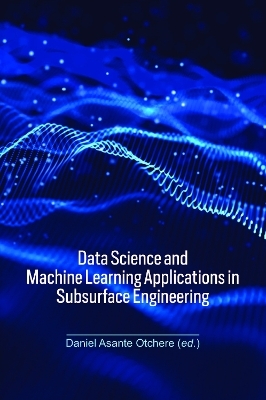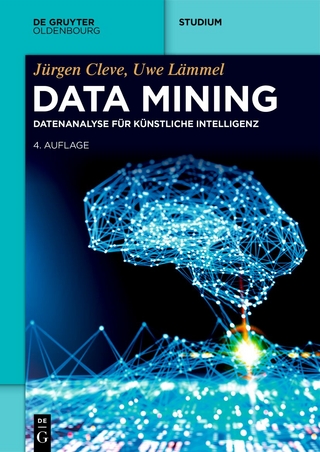
Data Science and Machine Learning Applications in Subsurface Engineering
CRC Press (Verlag)
978-1-032-43364-6 (ISBN)
This book covers unsupervised learning, supervised learning, clustering approaches, feature engineering, explainable AI and multioutput regression models for subsurface engineering problems. Processing voluminous and complex data sets are the primary focus of the field of machine learning (ML). ML aims to develop data-driven methods and computational algorithms that can learn to identify complex and non-linear patterns to understand and predict the relationships between variables by analysing extensive data. Although ML models provide the final output for predictions, several steps need to be performed to achieve accurate predictions. These steps, data pre-processing, feature selection, feature engineering and outlier removal, are all contained in this book. New models are also developed using existing ML architecture and learning theories to improve the performance of traditional ML models and handle small and big data without manual adjustments.
This research-oriented book will help subsurface engineers, geophysicists, and geoscientists become familiar with data science and ML advances relevant to subsurface engineering. Additionally, it demonstrates the use of data-driven approaches for salt identification, seismic interpretation, estimating enhanced oil recovery factor, predicting pore fluid types, petrophysical property prediction, estimating pressure drop in pipelines, bubble point pressure prediction, enhancing drilling mud loss, smart well completion and synthetic well log predictions.
Daniel Asante Otchere is an AI/ML Scientific Engineer at the Institute of Computational and Data Sciences (ICDS) at Pennsylvania State University, USA. He holds a PhD in petroleum engineering from Universiti Teknologi PETRONAS (UTP) in Malaysia, a Master's degree in Petroleum Geoscience from the University of Manchester in UK, and a Bachelor's degree in Geological Engineering from the University of Mines and Technology in Ghana. Professionally, Daniel has extensive experience across the mining and oil and gas industry, working on several onshore and offshore projects that have had a significant impact on the industry in Africa and South East Asia. He serves as a technical committee member of the World Geothermal Congress and teaches several AI topics on his YouTube channel "Study with Dani". His expertise has resulted in numerous collaborative research efforts, yielding several articles published in renowned journals and conferences. He was recognised for excellence in teaching and research in the Petroleum Engineering Department at UTP and received the 2021 best postgraduate student and the Graduate Assistant merit award in 2021 and 2022. He enjoys watching movies, listening to Highlife and Afrobeats music, hockey, and playing football. He also excels in the realm of video games, having won numerous PlayStation-FIFA tournaments held in the United Kingdom, Ghana, and Malaysia.
Foreword
Preface
1. Introduction
2. Enhancing Drilling Fluid Lost-circulation Prediction: Using Model Agnostic and Supervised Machine Learning
Introduction
Background of Machine Learning Regression Models
Data Collection and Description
Methodology
Results and Discussion
Conclusions
References
3. Application of a Novel Stacked Ensemble Model in Predicting Total Porosity and Free Fluid Index via Wireline and NMR Logs
Introduction
Nuclear Magnetic Resonance
Methodology
Results and Discussion
Conclusions
References
4. Compressional and Shear Sonic Log Determination: Using Data-Driven Machine Learning Techniques
Introduction
Literature Review
Background of Machine Learning Regression Models
Data Collection and Description
Methodology
Results and Discussion
Conclusions
References
5. Data-Driven Virtual Flow Metering Systems
Introduction
VFM Key Characteristics
Data Driven VFM Main Application Areas
Methodology of Building Data-driven VFMs
Field Experience with a Data-driven VFM System
References
6. Data-driven and Machine Learning Approach in Estimating Multi-zonal ICV Water Injection Rates in a Smart Well Completion Introduction
Brief Overview of Intelligent Well Completion
Methodology
Results and Discussion
Conclusions
References
7. Carbon Dioxide Low Salinity Water Alternating Gas (CO2 LSWAG) Oil Recovery Factor Prediction in Carbonate Reservoir: Using Supervised Machine Learning Models
Introduction
Methodology
Results and Discussion
Conclusion
References
8. Improving Seismic Salt Mapping through Transfer Learning Using a Pre-trained Deep Convolutional Neural Network: A Case Study on Groningen Field
Introduction
Method
Results and Discussion
Conclusions
References
9. Super-Vertical-Resolution Reconstruction of Seismic Volume Using a Pre-trained Deep Convolutional Neural Network: A Case Study on Opunake Field
Introduction
Brief Overview
Methodology
Results and Discussion
Conclusions
References
10. Petroleum Reservoir Characterisation: A Review from Empirical to Computer-Based Applications
Introduction
Empirical Models for Petrophysical Property Prediction
Fractal Analysis in Reservoir Characterisation
Application of Artificial Intelligence in Petrophysical Property Prediction
Lithology and Facies Analysis
Seismic Guided Petrophysical Property Prediction
Hybrid Models of AI for Petrophysical Property Prediction
Summary
Challenges and Perspectives
Conclusions
References
11. Artificial Lift Design for Future Inflow and Outflow Performance for Jubilee Oilfield: Using Historical Production Data and Artificial Neural Network Models
Introduction
Methodology
Results and Discussion
Conclusions
References
12. Modelling Two-phase Flow Parameters Utilizing Machine-learning Methodology
Introduction
Data Sources and Existing Correlations
Methodology
Results and Discussions
Comparison between ML Algorithms and Existing Correlations
Conclusions and Recommendations
Nomenclature
References
Index
| Erscheinungsdatum | 08.02.2024 |
|---|---|
| Zusatzinfo | 53 Tables, black and white; 6 Line drawings, color; 82 Line drawings, black and white; 12 Halftones, color; 19 Halftones, black and white; 18 Illustrations, color; 101 Illustrations, black and white |
| Verlagsort | London |
| Sprache | englisch |
| Maße | 156 x 234 mm |
| Gewicht | 752 g |
| Themenwelt | Informatik ► Datenbanken ► Data Warehouse / Data Mining |
| Informatik ► Theorie / Studium ► Künstliche Intelligenz / Robotik | |
| Naturwissenschaften ► Geowissenschaften ► Geologie | |
| Technik ► Bergbau | |
| Technik ► Elektrotechnik / Energietechnik | |
| Technik ► Umwelttechnik / Biotechnologie | |
| ISBN-10 | 1-032-43364-7 / 1032433647 |
| ISBN-13 | 978-1-032-43364-6 / 9781032433646 |
| Zustand | Neuware |
| Informationen gemäß Produktsicherheitsverordnung (GPSR) | |
| Haben Sie eine Frage zum Produkt? |
aus dem Bereich


